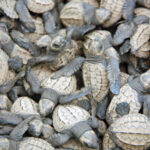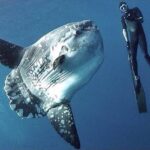
Photo by: greyloch
As an ocean lover and long-time fan of “The Little Mermaid,” I’ve daydreamed about plunging into the ocean and hanging with the dolphins, sea lions, and whales. I’ve considered getting SCUBA certified, but never gone through with it. The thick wetsuits, clunky air tanks and potential for the bends give my tranquil daydream a wake up call — SCUBA diving requires a lot of gear, a lot of training and a lot of guts.
When I heard about freediving, I thought it would make my mermaid fantasy come true. Freedivers dive deep underwater by holding their breath for minutes at a time with no extra breathing gear. But professional freedivers spend years training to push their bodies far beyond what the rest of us are capable of — any mistakes can result in serious injury or death.
Why can marine mammals, like sea lions, dive deep into the ocean to forage for food? Why are some human divers able to train themselves to dive hundreds of feet deep? How do marine mammals naturally do what we need equipment and training to do?
California sea lions can dive as deep as 450 feet to forage for food — twice the height of the Golden Gate Bridge. To get that deep, a sea lion might be underwater for 10 to 15 minutes with only a lungful of air to supply their oxygen. To chase their squid snacks around and get back to the surface, oxygen needs to get to their swimming muscles and brain cells.
So how do sea lions maintain enough oxygen to keep their brain and muscles functioning while swimming and foraging all in one breath?
In a study published in the Journal of Experimental Biology in October 2014, Birgitte I. McDonald and Paul J. Ponganis wanted to know what changes were happening in the bodies of sea lions as they dive down to great depths. They found that when it comes to diving, sea lions follow their hearts.
Well, their heart rates.
According to the article, the depth to which warm-blooded marine animals can dive depends on two things: the amount of oxygen their body can store and how quickly they deplete the oxygen supply. When mammals inhale, air races down the windpipe and fills up tiny air sacs in the lungs. Oxygen molecules pass through the air sac’s thin walls and into the blood stream. Catching a ride on red blood cells, the oxygen flows through blood vessels to the heart, and then gets pumped to the rest of the body.
The researchers measured sea lion’s heart rates and the depths to which they dove and found that for long, deep dives, a sea lion’s heart rate slows way down, a phenomenon called bradycardia. This makes sense — a slower heart rate pumps blood through the lungs and to the rest of the body less frequently, slowing the rate at which oxygen gets into the bloodstream. Instead, the sea lion becomes dependent on the oxygen already present in the muscle tissue and can use the oxygen saved in the blood to make it back to the surface.
It turns out that sea lions and human freedivers have something in common. In a review published in Physiology in 2013, W. Michael Panneton discusses the diving reflex — an automatic response that causes our heart rate to slow down and the vessels and arteries to constrict in the limbs. This forces the blood to flow to the most important organs — the heart and brain. The diving reflex allows babies to “hold their breath” underwater.
For humans, the reflex delays our breathing response for a few moments before we have to suck in air. However freedivers can learn to delay the response to dive deeper, hold on to more oxygen, and swim to their heart’s desire. Deep diving marine mammals naturally prolong the reflex.
Does this mean I’m ready to take the plunge to make my mermaid daydreams come true? Don’t hold your breath.







Comments are closed.